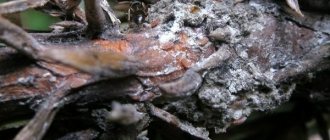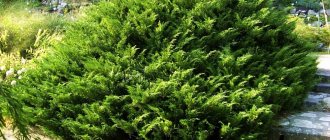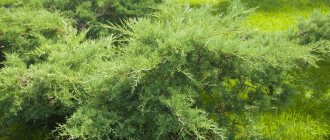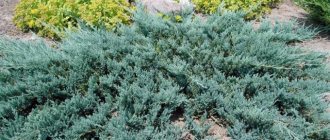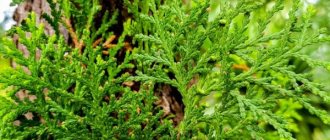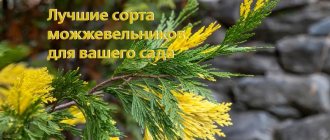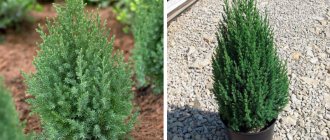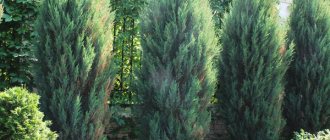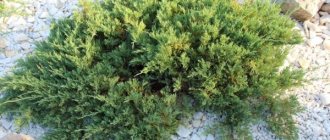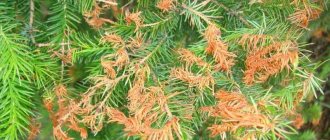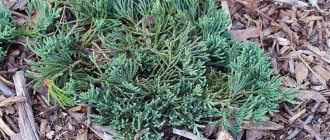Juniper is an amazing plant with powerful healing properties. Where it grows, the air is cleared of pollution. In Rus', houses were fumigated with smoke from burning branches to destroy pathogenic microbes. A person who inhales the aroma of this plant normalizes sleep and calms the nervous system. The tree's fruits and oil are used to treat diseases in folk medicine. In addition, juniper has a very interesting appearance, so it is also used for decorative purposes.
Origin of the name juniper
Other names for the plant are heather, mozzhuha, and yalovets. Juniper is a coniferous plant from the Cypress family. It is also popularly called brogueberry, red cedar, and Cossack juniper. Another variant of the name is archa. The etymology of the word has controversial versions. According to one of them, the name comes from the Old Russian mozha, which means “knot”. The Proto-Slavic word mezhg has a similar meaning, which meant “knit” or “weave.” Approximately the same epithet is given by the Latin word juniperus, which translated into Russian means “branches for weaving.” Another version says that the name of the tree comes from the fact that in the forest it often grows between spruce trees. That is, it is an interspruce tree, which is consistent with the modern term.
Gardeners' recommendations for planting
Gardening experts say that plants that have previously grown in small containers of no more than 5 liters take root best. It should be planted with a clod of earth; the roots should not be shaken off the soil. If you need to replant a large plant, and before that transport it, you need to carefully dig it out of the ground and wrap the lump of earth with the root system in burlap. It’s even better to place the bush in a special shipping container.
It is highly not recommended to replant an already mature specimen. This is explained by the fact that an adult columnar juniper has a complex root system that grows extensively over the surface, so it is impossible to dig up a bush without damaging the root system. This procedure will inevitably destroy the plant.
Where does juniper grow?
Plants of this genus are distinguished by their good adaptability to different climatic conditions. Therefore, different types of junipers can be found on all continents. Tree-like representatives with large, tall trunks form entire forests in Central America, Asia, and the Mediterranean. Large specimens also grow on the African continent. Smaller, bushy plants are ubiquitous. Some species are found in the Arctic, others in the subtropics. On the territory of our country, juniper is found in forests, steppes, and mountainous regions.
Solid
The variety naturally grows on rocky terrain.
The species is also called rigid, Juniperus rigida. At the age of 30 it grows 6.5 m upward, the trunk circumference is 10 cm. Juniper grows slowly, is frost-resistant, light-loving, and has little demand for soil. The variety naturally grows on rocky terrain. Wood is not subject to rotting processes.
The shape of the aboveground part is columnar, oval or narrow pyramidal. The branches are triangular, directed upward, then become prostrate. Young shoots hang down. The bark is first grayish, then reddish-brown, furrowed. The leaves are hard, dense, sharp, prickly, yellowish-green. Juniper cones are round, small, black and blue, covered with a blue coating, and ripen in the second year of cultivation.
What does juniper look like?
Representatives of the juniper genus have different structures and appearances. In total there are about 70 varieties. All of them are evergreen. Plants can be divided into three categories:
- Tree-like
- Shrubs
- Creeping
The first group includes trees growing up to 20-30 meters in height. They have a thick trunk and a spreading pyramidal crown. Shrubs are distinguished by flexible shoots scattered in different directions. The height of this type of plant is up to 0.5-1 meters. The third type has creeping roots, thanks to which it spreads over the surface of the earth, like moss. The branches grow to the sides and upwards. Juniper plant species are long-lived. They can grow up to 600 years.
Juniper branches are covered with needles or scales, which are modified leaves. They can be tightly pressed or growing in different directions. The structure of female and male kidneys is different. Male ones are spikelets with several stamens. Females are shorter, round in shape, with two or three ovules. The plant blooms in June and produces fruits at the end of summer.
Scaly
Scaly juniper (Juniperus squamata) is suitable for all landscape gardens. Individual varieties can be selected or combined with other species and groups of plants in such a way as to obtain the effect of multi-storey plantings.
Recommended varieties are presented below.
Blue Star
Juniper flake Blue Star is a low variety (up to 1 meter) with a compact flattened spherical shape.
Meyeri
Scaly juniper Meyeri is a variety with a loose crown of irregular shape. It grows slowly, reaches 4 meters.
Blue Carpet
The Blue Carpet variety is a low, spreading, relatively fast-growing juniper. At the age of ten it reaches a height of 30 cm and 2 m in diameter. The plant covers the surface of the ground quite densely, so you should not plant delicate plants next to it, which will be suppressed by it. It has an original, very beautiful blue pine color.
Juniper berries
Juniper fruits also have an unusual appearance. They have a cone-like structure - they consist of several scales tightly adjacent to each other. Because of this structure, they are also called cone berries. Shape: spherical or elliptical. The texture is dense, hard, and there are seeds inside. At first the berries are green, as they ripen they acquire a beautiful blue-blue hue, and when ripe they turn brown or purple-black. The fruits are edible, but they are not used for food. They taste spicy, with a bitterness.
Features of cultivation
Cultivating the group of plants in question will not cause any trouble. This is an ideal option for those who are limited in territorial area, but want to grow a coniferous variety. Also, the described plant is suitable for those who have a summer cottage located far away and do not have the opportunity to constantly devote a lot of time to care. Planting can be done anywhere on the site - the main thing is that it is well lit by the sun.
Minimal shading is acceptable. Planting is carried out in April - May, depending on climate conditions. Select seedlings that are at least 3 years old - they take root better. They are sold in 5 liter containers. When transplanting into open ground, be sure to preserve the earthen ball. Between large plants leave a distance of 2 m; for small plants 50 cm will be enough.
Important! When planting, make sure that the root collar rises 5–8 cm above the ground level. Otherwise, the seedling may not take root.
Planting is carried out using the transshipment method, having first dug a hole 2 fingers larger in diameter and height than the container. The planted plant is watered with 5 liters of water and then mulched with sawdust or peat. The mulch layer should be about 8 cm. Throughout the season, plants should be watered only in extreme heat. One specimen will require from 10 to 20 liters of water.
The tree trunk circle is loosened once a month. Remove weeds regularly. Fertilize once a year, in the spring: 30 g of nitroammophoska is embedded in the tree trunk circle. The plants do not need pruning. This manipulation is carried out only when it is necessary to form a hedge. Sanitary pruning is carried out as necessary. At the same time, branches that thicken the crown and grow inward are removed.
Video: common juniper
Juniper varieties
The good decorative qualities of juniper contribute to its widespread use in landscape design. This is a popular plant for landscaping parks and urban areas. Breeders are constantly developing new varieties that combine unpretentiousness and attractiveness. Trees and shrubs can have needles of blue, golden, and emerald shades. The branches form interesting combinations that give the plant an exotic appearance. Here are a few common juniper varieties that look beautiful on the site:
- Common juniper
- Gold Con
- Sentinel
- Tamaris
- Golden Carpet
- Ice Blue
Common juniper is one of the most common varieties. It is often planted in city parks or along roads. This is a tall tree with a trunk length of up to 10 meters. The crown is cone-shaped, column-shaped. It tolerates polluted city air well and purifies it. Easily takes root on rocky and sandy soils.
Gold Con is a spectacular variety with golden needles, bred in Germany. The trees are columnar, narrow, up to three meters high. In summer, the needles are yellow in color; in winter they turn brownish. The plant is planted in parks to frame paths.
The Sentinel variety is similar in shape to Gold Con. It was bred by Canadian breeders. The trees are thinner and lower - 30 cm in diameter (including needles), height - 1-1.5 meters. The branches are pressed against the trunk, thereby creating a neat, even surface. The needles are a beautiful emerald or bluish color.
Tamaris is a variety of the popular Cossack variety. It is a shrub that reaches a height of about a meter in adulthood. The branches grow, spreading out to the sides, which is why the plant acquires an upwardly expanded crown. Tamaris grows up to two meters in diameter. This variety is used for framing stones and filling small lawns.
Golden Carpet is a low-growing shrub with shoots pressed to the ground. Golden needles give the plant brightness, and short, vertically directed branches give it an unusual appearance. The juniper reaches one and a half meters in circumference and 25-30 cm in height. It looks very impressive in flower beds and round lawns. The shoots, growing, destroy weeds.
Ice Blue is a low shrub with creeping branches. It grows horizontally, up to 15 cm in height. This variety of juniper creates a beautiful horizontal carpet up to two meters wide. The color of the needles is bluish. Looks impressive on lawns with high borders, falling from them like a wave.
Thuja - description, photo, care
Thuja is another favorite of summer residents, perfect for creating hedges or interesting landscape compositions with many other plants (the only thing is that she doesn’t really like it when spruce, pine or fir are nearby). They love this crop for its decorativeness, ease of care, rapid growth, resistance to drought, frost and air smoke, and ease of crown formation.
In young thuja plants, the leaves are soft, needle-shaped, in adults they are scale-like, crosswise opposite, also with oil glands. Unlike cypress, thuja needles are located in one plane, and they also smell sweet - healing aroma oil is also obtained from it, although its use is indicated for completely different ailments than cypress.
Like cypress, thuja is a monoecious plant. But its cones are much smaller than cypress cones (7-10 mm), always have an elongated oblong shape and several pairs of scales, which are arranged crosswise. The seeds are flat, with two narrow wings.
The species Thuja orientalis, widely used in ornamental gardening, also known as Biota orientalis, is now not considered as part of the Thuja genus. Its correct name, according to modern views, is the eastern flatweed. Its main feature is the absence of resin glands in the needles, unlike all types of thuja.
Thanks to the huge variety of garden forms and varieties of thuja, every summer resident can choose a plant that is suitable specifically for his site - dwarf or tall, spreading or compact, with a pyramidal or spherical crown, green, yellow-orange, bronze or light green needles.
Most often in our gardens you can find varieties of thuja occidentalis, although Japanese with a wide-pyramidal crown, folded with drooping flat shoots and colored foliage, and Korean with a white-silver “underside” of needles are also used as an ornamental plant.
- Thuja - growing features
How to properly care for thuja?
The benefits and harms of juniper
Juniper is a plant unique in its valuable qualities. Berries, bark, roots, pine needles, and cones have medicinal properties. The fruits contain useful elements such as:
- sucrose
- pectin
- organic acids
- camphor
- glucose
- wax
- borneol
They also contain iron, manganese, copper, vitamin C. Cones and pine needles contain essential oils, resins, organic fats, and phytoncides. Rhizomes and bark contain tannins, natural alcohol compounds, and bitterness. All parts of the plant are actively used in alternative medicine. Decoctions and teas based on them have the following effects on the body:
- bactericidal
- anti-inflammatory
- painkiller
- regenerating
- soothing
- diuretic
Contraindications for drinking juniper drinks include allergies to the fruits and the smell of the plant's pine needles. You should not take such medicinal formulations during pregnancy or exacerbation of renal failure. If fruits are abused, undesirable manifestations are possible in the form of indigestion, nausea, and skin reactions.
Benefits of juniper tea
Juniper is used in folk medicine, cooking, cosmetology, and landscape design. In addition, dishes and other household items are made from its wood. Trees are protected from cutting down, so mostly dead wood is used for crafts. Wooden containers disinfect food; root vegetables and mushrooms are stored in them.
The plant is most widely used in alternative medicine. Decoctions, infusions, teas, and mixtures for inhalation are prepared from all parts of the tree. With the help of juniper fruits and branches, diseases of the urinary tract and digestive tract are treated. Drinks made from berries relieve symptoms of indigestion and eliminate diarrhea. A decoction of fruits and cones removes kidney stones and relieves swelling. For diseases of the respiratory tract, medicinal infusions eliminate cough and remove phlegm.
Inhalations of pine needles clear the nasopharynx and disinfect the lungs. Berry-based drinks treat nervous disorders, calm, and relieve anxiety. Pine baths are useful for colds and depression. Compresses made from bark decoction relieve joint pain and alleviate the symptoms of rheumatism. The roots are used to treat gastrointestinal ulcers, tuberculosis, and dermatological pathologies.
Bath brooms are made from juniper branches. They are distinguished by powerful medicinal properties. A steamed broom exhibits anti-inflammatory and bactericidal properties and tones the skin. Therapeutic pillows are made from wood shavings by stuffing a bedstead with it. They are used against insomnia, neuralgic diseases, and pain in the head and neck area. The released oils relax the nervous system, disinfect the air, and cleanse the respiratory tract.
Juniper fruit extract is added to caring and nourishing creams for the face and body. Cleansers remove fats, free sebaceous ducts from impurities, and tighten pores. The oil is used for hair and skin care. It stimulates cells to renew and removes toxins.
Fresh berries are used to treat diseases and strengthen the immune system. They are chewed by grinding the dense pulp with the teeth along with the seeds. They are not eaten raw. In cooking, crushed dried juniper fruits are used as seasonings. This additive gives food an unusual taste. Berries are added to meat, game, and main courses. The juice from them is used to prepare low-alcohol drinks.
In landscape design, juniper bushes and trees are used to create alpine slides and design rocky compositions. Low trees are used to make hedges and frames of park areas. Horizontal types of shrubs strengthen slopes and slopes. Low spreading bushes look good in group compositions with other plants.
Juniper oil
An oil with valuable properties is produced from the wood of juniper trees. It is used for medicinal and cosmetic purposes. The oil can be taken internally and externally. This substance is used to rub joints for rheumatism and arthritis. It is used for healing massage. In case of gum disease, it is used to wipe the inflamed areas. Drink oil in small portions to thin the blood for diseases of the cardiovascular system. It is also used in weight loss diets. Oil lotions treat skin pathologies such as psoriasis, eczema, and lichen.
Juniper oil is used as a mask for skin care. It rejuvenates and accelerates metabolism in the epidermis. The substance is suitable for any skin type. It nourishes, moisturizes the dermis, makes it elastic. It is especially good for oily skin. Rubbing with oil cleanses the skin of impurities and helps get rid of acne. It is also good for hair. Rubbing into the scalp promotes the growth and strengthening of hair follicles. Massaging this area with oil helps get rid of dandruff. The mask along the entire length of the hair evens out the cuticles and restores their structure. The oil glues damaged hair ends together and gives them an aesthetic appearance.
Interesting facts about juniper
- Juniper is a symbol of eternal life. In Greco-Roman mythology, it personifies protection and confidence. Since ancient times, this plant was considered magical, expelling dark forces. The wood of the plant is used to make amulets and amulets. In the old days, juniper branches were laid out inside residential buildings and cattle pens.
- This plant helps preserve marriage and protects the family from misfortunes. In relationships, juniper symbolizes trust and harmony. Twigs placed in a vase bring peace to the family and protect against quarrels.
A tree planted near the house will give peace and peace of mind. It will not only decorate the area, but also enrich the air with healing substances.
